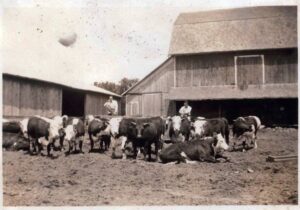
Roy and Murlyn Wilson stand with cows on the family farm on C.R. 800E near Mongo in the 1930s. At left, Murlyn is shown as a U.S. Army private and a star Indiana University runner. (Photos Contributed)
A century ago, a LaGrange County legend was learning to walk at his family’s farm northeast of Mongo.
By the time Murlyn Wilson was a teenager at Springfield Township High School, he was a stand-out track star. He excelled at the 800-yard and one-mile runs and became known as the Mongo Miler, representing his high school at a 1938 sectional meet and winning the mile as a “one-man track team,” said his nephew Richard Rhodes, a former Elkhart resident who now lives in Naples, Florida. Though Murlyn was the only Springfield Township competitor, his high school took fourth place in the sectional.
Coach Billy Hayes recruited Murlyn for the Indiana University track program. His sophomore year, the team won the 1940 Big Ten and NCAA championships.
Then, everything changed. The events that led to World War II sent shock waves throughout the country and in a united show of patriotism, the entire IU track team enlisted. All returned from the war except Murlyn, a paratrooper who died in France on D-Day, June 6, 1944, at the age of 23.
Local legacy
Rhodes and Keith Dunkel of Indianapolis never met their Uncle Murlyn but they want to keep his memory alive.
Murlyn has been compared to Don Lash of Auburn, who also attended IU and was known as “the first great American long-distance runner,” said Dunkel.
“He was a word-class runner,” said Rhodes, whose mother, Kathryn “Kitty,” was Murlyn’s sister; he was 10 years her senior.
Roy and Lydia “Neva” Wilson had four children following their marriage in 1915, and Murlyn was the only boy along with sisters: Evelyn, Kitty and Lois – Dunkel’s mother. Dunkel said his interest in his uncle came from his mother in the mid-1980s.
“The memories were still very poignant to her,” he said. She passed away several years ago, and Dunkel inherited family relics. Among them are a 48-star flag used during Murlyn’s American funeral. It has never been unfolded.
“Passing this on is important to me,” Dunkel said. “There’s still a story to be told about him.”
The historical significance of those who fought in WWII is “priceless,” he said. In his studies, he has been touched by “the presence of God in people’s lives.”
Family heritage
Rhodes said his mother rarely spoke of her brother due to the heartbreak the family carried following the loss.
He lived his early life in LaGrange, where his father operated Rhodes Tire and Packard dealership as well as a mobile root beer stand. The family moved to Elkhart in 1960 when his father took a job with the Internal Revenue Service.
Dunkel, a 1968 Prairie Heights High School graduate, grew up on the family farm on C.R. 800E, purchased in the late 1800s by his great-grandfather Melvin Wilson. Dunkel’s father, Wilford, also served in World War II. When he returned, he and Lois raised their family in a small house across the road from Melvin and Neva’s. When the Wilsons got older, they chose to live in the smaller house and the Dunkels moved into the farm manor when Keith was about 9 years old. His grandparents never talked about Murlyn.
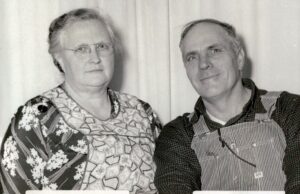
Roy and Neva Wilson of rural LaGrange, shown in 1952, rarely spoke of their son due to their heartbreak from his early death. (Photo Contributed)
“It was just such a tremendous pain they bore,” Dunkel said.
He was interested in the war, though his father shared few details of his own experience abroad.
Historical heirlooms
One day, Dunkel discovered a few items that had belonged to Murlyn, and they opened a small window to his uncle’s memory.
“I found his purple heart that they kept in a closet,” Dunkel said. He also found a box of letters to and from Murlyn during the war, including a birthday note to Kitty dated July 26, 1942. He tells about his first jump from an airplane and his plans to skydive every day that week.
“Well, sister, I would send you a little bigger present, but I only got paid $30,” he wrote.
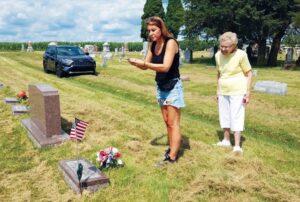
Kathryn Wilson Rhodes visits her brother Murlyn’s grave with granddaughter Lori Rhodes. It was Kathryn’s last visit to the gravesite after finding out she had terminal cancer. (Photo Contributed)
A Western Union telegram on July 7, 1944 informed the family that Murlyn was “missing in action” following the D-Day battles. Another telegram on Aug. 11, 1944 confirms he was killed in action.
A typewritten letter from Brigadier General James M. Gavin was sent Sept. 6, 1944.
“Private Wilson was a loyal and conscientious soldier who displayed extreme courage and aggressiveness when in combat with the enemy,” the letter says. “He was held in high esteem by everyone who knew him, both officers and men, and he will be missed greatly in the hard days ahead.”
A more personal letter – sent to Murlyn’s parents by a fellow soldier on Sept. 15, 1944 – referred to Murlyn as “a fighting fool.”
“The fellows in the company thought he was a very swell guy and a good soldier,” wrote Sgt. W. Whitman. “I can assure you that you can be very proud of your son.”
Murlyn was killed by machine gun fire from a low-flying airplane. Whitman said he was hit by a “fragmentary shell.” He had jumped into the fray around 1:30 p.m. and was killed while marching later in the day.
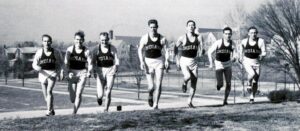
The Indiana University national championship running team is shown in 1940. Murlyn Wilson is second from right. (Photo Contributed)
“He would have been heir to the family farm,” said Rhodes.
Family memories
Like Murlyn, Dunkel attended Springfield Township High School. He remembers traveling to Orland High School to use the gym and play football.
Dunkel went from a 12-person class in Mongo to a 77-person class at Prairie Heights in 1965, his sophomore year, when Prairie Heights schools were established.
In his tender teens, Dunkel dealt with a tragedy similar to his mothers’. His brother, Larry, died in a hunting accident at 15 years old.
“He was built just like Murlyn was,” Dunkel said. Larry had the lean figure of a runner, while Keith was stockier and more suited to football.
Because Keith wasn’t interested in farming, the farm was sold about 30 years ago to the Mireley family.
“I go by there a couple of times a year, just to reminisce,” he said.
He visits Murlyn’s grave in English Prairie Cemetery. While Murlyn was initially buried close to where he was killed near St. Mere Eglise, France, his body was returned in May 1948.
Dunkel and his wife have also traveled to the site in Normandy where the deadly battle occurred. He scooped up a bit of soil, he said, and left a photo of Murlyn to mark the place of his death.
Murlyn enlisted in the U.S. Army on Feb. 28, 1941 and chose to train as a paratrooper because it paid better than some other positions. Times were tough in America, and Murlyn wanted to help support his family.
“Back then, they were foreclosing on farms,” Rhodes said.
Dunkel said he has a photo of Roy, Neva and their children with a new 1938 Ford coupe, quite a luxury in those days. What the photo does not show, he noted, was that the car was not driven for five years because the Wilsons had to donate the tires for rubber rationing.
Murlyn graduated from paratrooper school in Fort Benning, Georgia, on July 31, 1942 and served in the 82nd Airborne Division, 505th Parachute Infantry Regiment, Co. B. He did some training in North Africa and completed combat jumps in Sicily and Italy before the D-Day mission that took his life.
The same year, Coach Hayes died unexpectedly, bringing an IU legend to a close.
“For years there was a photo in the Assemby Hall lobby of that team,” said a Nov. 11 article about the life of Murlyn Wilson by Gregg Doyel in the Indianapolis Star, “seven young men running up a hill, some of them smiling for the staged photo. Look at the young man, second from the right. He’s not smiling. That’s Murlyn.”


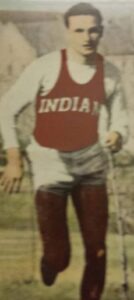
Loading Comments